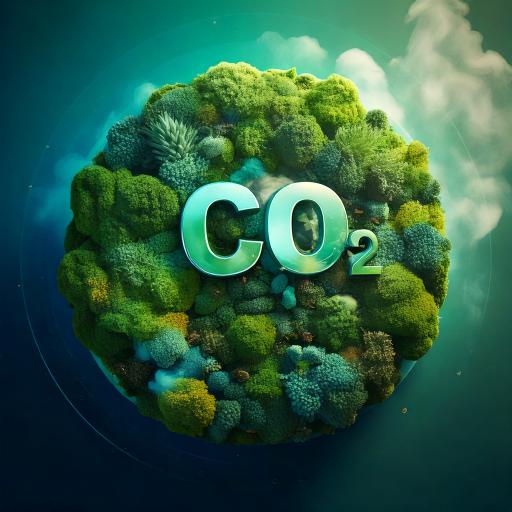
Climate balance is essential to ensure a prosperous future for all. Carbon dioxide (CO2) emissions, which account for about 76% of the greenhouse gases responsible for global warming, can be significantly reduced through sustainable actions, both individual and collective (Intergovernmental Panel on Climate Change, IPCC, 2021).

What are CO2 emissions and how are they generated?
Carbon dioxide (CO2) is a colorless gas that is released into the atmosphere primarily as a result of the burning of fossil fuels, such as oil, coal and natural gas. These fuels are used to generate power, drive vehicles and in many industrial processes. When fossil fuels are burned, they release CO2, which accumulates in the atmosphere and contributes to the greenhouse effect, warming the planet.
How does a person generate CO2 emissions on a daily basis?
People also generate CO2 through everyday activities such as:
Transportation use:
Driving a car or flying generates large amounts of CO2. For example, a flight between Mexico and New York can generate up to 2 tons of CO2 per passenger.
Household energy consumption
Using electricity and gas emits approximately 4.6 tons of CO2 per year per household (EPA).
Feeding
Meat-rich diets generate more emissions than vegetarian diets; a diet rich in red meat can generate up to 4.8 tons of CO2 per year (University of Oxford, 2018).
Consumption of goods and services
Every product we buy requires energy to manufacture. For example, a smartphone can emit between 16 and 80 kg of CO2 in its entire life cycle (University of Bath).

The Effect of CO2 on Climate Change
Carbon dioxide (CO2) is one of the main greenhouse gases, and its accumulation in the atmosphere has several direct effects on climate change:
When CO2 accumulates in the atmosphere, it acts as a blanket that traps heat. This causes an increase in the average temperature of the planet, a phenomenon known as global warming. Since the pre-industrial era, CO2 concentrations have increased by more than 45%, resulting in an increase of approximately 1.1°C in global temperature (IPCC, 2021).
Rising global temperatures contribute to changes in weather patterns, resulting in extreme events such as more intense heat waves, torrential rains, hurricanes and prolonged droughts. These conditions not only affect ecosystems, but also food production, access to water and infrastructure security.
Global warming is accelerating the melting of glaciers and ice sheets in Greenland and Antarctica. This contributes directly to sea level rise, which threatens inhabited coastal areas. According to NASA, sea levels have risen by about 20 cm in the last century and continue to rise.
CO2 is also absorbed by the oceans, which reduces the pH of the water and makes it more acidic. This acidification has a direct impact on marine life, affecting corals, mollusks and other species, and altering the balance of marine ecosystems (NOAA).
Corporate Engagement in Mexico, Central America and the Caribbean
In Mexico and Central America, many companies are taking the lead in reducing CO2 emissions through sustainability and circular economy programs. These actions seek to reduce dependence on fossil fuels, implement renewable energies and optimize production processes to minimize environmental impact.
Leading companies in sectors such as manufacturing, construction and energy are investing in cleaner technologies and adopting emission reduction policies. Initiatives such as installing solar panels, optimizing logistics to reduce unnecessary transportation, and reusing recyclable materials in production processes are examples of how these industries are committed to sustainability.
According to the Business Alliance for Sustainability in Latin America, these collective actions have led to a reduction of up to 20% of industrial CO2 emissions in some sectors.
This corporate commitment is not only aligned with the United Nations Sustainable Development Goals, but also inspires more companies to follow this path and demonstrates that transformation towards a sustainable future is possible.

have enabled the reduction of industrial co2 emissions in some sectors.
The Importance of Individual Action in CO2 Reduction
While companies have a key role to play, each of us can also contribute from our own trenches. Reducing energy consumption at home, opting for public transportation, consuming local and sustainable products, and participating in recycling activities are just some of the ways we can make a difference.
With every small action, we can all be part of the solution. From our daily decisions to corporate-level efforts, together we are transforming the world, one action at a time. As individuals, our decisions and habits count; and as communities, we can multiply that impact.

How to Reduce your Carbon Footprint
Here are some concrete ways to reduce your CO2 footprint:
Energy efficiency
Switching to LED bulbs and using energy efficient appliances reduces costs and energy consumption (IEA, 2021).
Renewable energy
Using renewable sources such as solar or wind can cover up to 70% of global energy needs by 2050 (IRENA, 2021).
Sustainable mobility
Choosing to walk, cycle or use public transport helps reduce emissions from transport, which accounts for 25% of global CO2 emissions (United Nations, 2022).
Responsible consumption
Choosing sustainable and recyclable products can reduce resource consumption and emissions associated with production.

